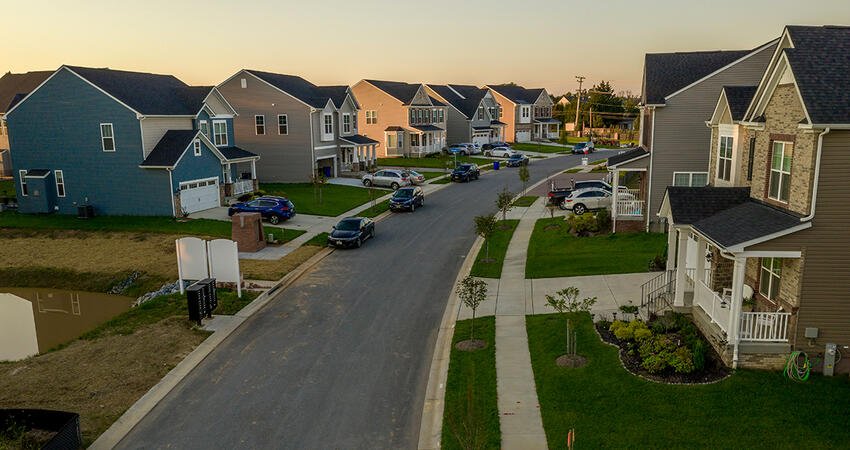
(tokar/Shutterstock)
How HOAs Can Shape Neighborhoods
Homeowners’ associations (HOAs) often make the news for high fines or strict rules about landscaping. But the consequences of their decisions can be more serious for a growing number of Americans.
Today, around 27 percent of people in the US live in an HOA community, but participation is expected to grow, as 60 percent of new single-family homes are being built in HOA communities. These private-ownership communities can determine who can live in their neighborhoods because of how they implement and enforce rules—and historically, this has led to increased racial segregation. How can local governments ensure HOAs can’t discriminate against residents of color and circumvent their laws?
How HOAs’ restrictions shape neighborhoods
HOAs are typically resident-run organizations that preside over a neighborhood, primarily focused on maintaining common spaces and upholding the appearance of the community. An HOA is created either when a new subdivision of houses is built or when all the neighbors get together and decide to create one. New buyers must continue to abide by the HOA.
HOAs played a critical role in the initial segregation of the suburbs, and they continue to exclude residents of color. In the 1960s, white residents used these associations to prevent Black families from moving into white suburban neighborhoods, often with explicit racial covenant language that some maintain.
Despite the end of these racial restrictions’ enforcement, white and Asian residents disproportionately inhabit HOAs compared with non-HOA areas, including other communities with high rates of homeownership. This may be because “demand for HOAs is driven at least in part by a desire for exclusion,” as the authors of one study wrote.
But these associations can discriminate against prospective homeowners and renters by enforcing requirements that disproportionately exclude people of color because of structural barriers, including requiring minimum credit scores, conducting background checks, and charging high fees. Some HOAs have attempted to prevent homeowners from renting to households that receive federal housing assistance,66 percent of whom are Black and Latinx families (PDF).
Other communities have turned to banning renting all together, which can create further inequities. While institutional investors have purchased single-family homes to turn them into permanent rental stock, many communities have voiced growing concerns around how these buyers can constrain the housing supply, reducing homeownership rates and wealth accumulation. Some HOAs have fought back against these investors through rental bans, but these rules exclude families for whom homeownership is out of reach, including families of color. A recent study in the Netherlands found that banning these buyers led to an increase in purchases by first-time homebuyers and an increase in rental prices, which can put further pressure on these households.
The challenges of legislating HOAS
Local leaders often welcome HOAs because they finance new development in exchange for governing power, but this can be a dangerous trade-off. Because HOAs are private entities that own the entire community, they can institute their own “private zoning” and other rules outside of local government regulations. They can also enforce rules however they want, including inequitably, leading some homeowners of color to sue their HOA over claims of racial discrimination.
As states seek to implement upzoning or other inclusive land-use laws, some local leaders have steered clear of challenging HOAs’ authority. When Seattle and California passed statewide inclusive zoning legislation, state leaders explicitly exempted HOA neighborhoods or clarified that the law would not invalidate existing HOA agreements. This may become more of an issue as more localities move to implement upzoning and more HOA communities fight back against inclusive zoning efforts or are exempted from them.
How to keep neighborhoods open to all
This issue is complicated because it involves intersecting factors including institutional investors, neighborhood rights, and discrimination. But local leaders can address these complexities.
- Implement specific protections for homeowners and renters
Localities have proposed bills to bar HOAs from implementing bans against housing assistance recipients. Texas, which was the site of the source-of-income (SOI) controversy last year, just passed an HOA SOI protection rule statewide. Other states are looking at homeowner protections, including reducing the power of HOAs to take liens out on properties over small issues. - Change zoning and other regulations to build more and different types of housing
Nearly one-third of neighborhoods across the country have few rental units, and these places are disproportionately suburban, have higher incomes, and have a larger share of white households. Exclusionary land policies contribute to segregation, as they constrict the amount of housing that can be built, increasing the demand and the costs. Building more and different types of housing increases choice for homeowners and renters. Additionally, increase housing supply can reduce costs, which can make homeownership accessible for more families and reduce investor interest in real estate.
HOAs are just one piece of our modern housing system that perpetuates racial discrimination. By expanding protections and housing options, local governments can reduce the impact of discrimination for both renters and homeowners.


